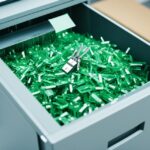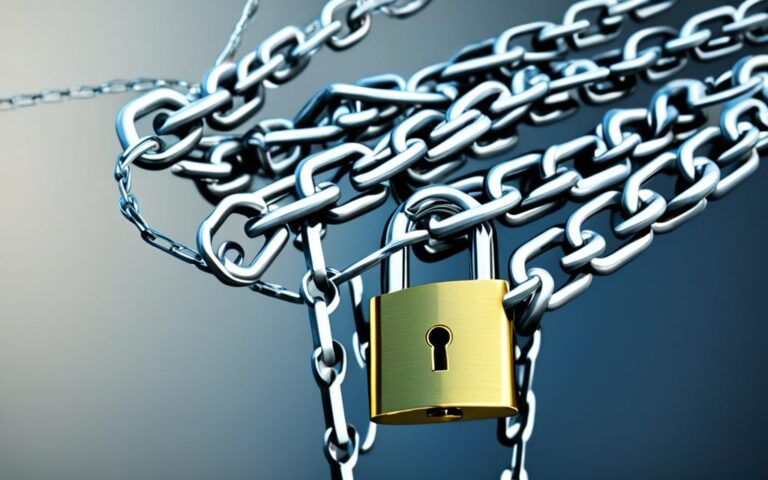Data Recycling for Secure Data Management
Data recycling offers a secure and effective solution for managing and disposing of redundant IT assets. By securely destroying and removing data from devices, companies can prevent unauthorized access and ensure compliance with regulations. This not only protects sensitive information but also provides numerous benefits for businesses.
One of the key benefits of data recycling is its positive impact on the environment. By preventing electronic waste from ending up in landfills, companies can reduce their carbon footprint and contribute to a greener future. Additionally, data recycling can generate financial advantages through the reuse, refurbishment, and resale of IT assets.
Choosing a reliable IT recycling company is essential for secure data management. It is important to select a company that uses tried and tested methods of secure data destruction, such as data overwriting and physical destruction. In this way, businesses can ensure the complete and secure disposal of confidential information.
Next, we will explore the benefits of data recycling, the secure methods of data destruction, and the environmental advantages it offers. Stay tuned!
Benefits of Data Recycling
Data recycling offers numerous benefits, making it a crucial component of sustainable data management. By securely destroying and removing data from devices, companies can prevent sensitive information from falling into the wrong hands, consequently safeguarding their reputation and minimizing the risk of data breaches and associated consequences.
Additionally, data recycling plays a vital role in promoting environmental sustainability. By preventing electronic waste from being disposed of in landfills, it helps reduce the environmental impact of IT asset disposal, thus contributing to a greener future.
Furthermore, data recycling can generate financial advantages for businesses. This is achieved through the reuse, refurbishment, and resale of IT assets. By extending the lifecycle of these assets, organizations can optimize their investments, reduce costs, and enhance overall resource efficiency.
“Data recycling not only offers data security and environmental benefits but also provides financial advantages through the reuse and resale of IT assets.”
Overall, data recycling offers a holistic approach to sustainable data management, encompassing data security, environmental responsibility, and financial optimization. By partnering with reliable IT recycling companies, businesses can effectively manage their data, protect their bottom line, and contribute to a more sustainable future.
<!–
Table 1: Comparative Analysis of Data Recycling Benefits
| Benefits | Data Security | Environmental Sustainability | Financial Advantages |
|---|---|---|---|
| Prevention of data breaches | Reduced electronic waste in landfills | Reuse, refurbishment, and resale of IT assets | |
| Mitigation of reputational risk | Lower carbon footprint | Optimized resource efficiency | |
| Protection of sensitive information | Reduction in harmful toxins released into the environment | Cost reduction |
–>
Secure Methods of Data Destruction
When it comes to secure data destruction, IT recycling companies employ various methods to ensure the complete eradication of sensitive information. Two commonly used techniques are data overwriting and physical destruction.
Data Overwriting
Data overwriting is a widely recognized and preferred method for secure data destruction. It involves writing zeros or specific patterns of data to the entire drive multiple times, making it virtually impossible to recover any previous data. By repeatedly overwriting the existing data, the original information becomes unreadable and irretrievable.
This method is highly effective and recommended for securely wiping data from functional IT assets. It provides a cost-effective and environmentally friendly approach to data destruction, as the devices can be reused or resold after the secure data overwriting process.
Physical Destruction
In cases where data overwriting cannot be verified due to faulty or low-capacity data-bearing assets, physical destruction and shredding methods are employed. This ensures that the information on the devices is completely irrecoverable.
Physical destruction involves shredding the asset into tiny pieces, effectively rendering any data unrecoverable. By destroying the devices, the risk of any potential data breaches is eliminated, providing an extra layer of security for sensitive information.
At Chaps IT Recycling, a trusted name in the industry, they utilize a hard drive punch to physically destroy the platters. This method not only guarantees the complete destruction of data but also allows for the recovery of valuable precious metals found in the drives, promoting sustainable and responsible electronic waste management.
Overall, the combination of data overwriting and physical destruction ensures that all data-bearing assets are securely and irreversibly destroyed, providing peace of mind for businesses and organizations.
| Secure Data Destruction Methods | Advantages |
|---|---|
| Data Overwriting |
|
| Physical Destruction |
|
Drawbacks of Degaussing
Degaussing, the traditional method used to scramble the magnetically stored data on hard drives, presents certain limitations and challenges in secure data destruction. While it has been a widely employed technique, there are drawbacks that have made it less preferred in comparison to software overwrite methods.
- Degaussing requires precise knowledge of the magnetic field of each data-bearing asset being degaussed. This demand for accurate magnetic field information makes it a complex process that requires specialized expertise.
- Compared to software overwrite methods, degaussing is potentially less reliable in ensuring complete data destruction. The inability to guarantee 100% effectiveness raises concerns about the potential for data recovery.
Due to these limitations and the lack of complete assurance in data destruction, many IT recycling companies do not consider degaussing as a viable option for secure data destruction.
| Drawbacks of Degaussing | Limitations |
|---|---|
| Requires precise knowledge of the magnetic field | Complex process |
| Potentially less reliable than software overwrite methods | Inability to guarantee 100% effectiveness |
Environmental Benefits of Data Recycling
Data recycling plays a crucial role in reducing the carbon footprint and promoting environmental sustainability. By preventing electronic waste from ending up in landfills, it helps to minimize the release of harmful toxins into the environment. This process not only reduces the environmental impact of IT asset disposal but also contributes to a greener and healthier planet.
When electronic devices are disposed of in landfills, they can release hazardous materials such as lead, mercury, and cadmium into the soil and water, posing serious risks to human health and the ecosystem. However, by recycling data-bearing devices, businesses and individuals can prevent these harmful substances from polluting the environment.
In addition to minimizing the release of toxins, data recycling also allows for the extraction and recycling of valuable materials from devices. By recovering and reusing materials such as gold, copper, and silver, the need for raw material extraction is reduced. This not only conserves natural resources but also helps to reduce greenhouse gas emissions associated with mining and manufacturing processes.
Data recycling also promotes energy efficiency. The process of mining and manufacturing new electronic devices requires significant amounts of energy. By reusing and refurbishing existing devices, the energy consumption and carbon emissions associated with the production of new devices can be significantly reduced.
Choosing to shred and recycle with reputable IT recycling companies ensures that electronic waste is responsibly managed, further reducing the environmental impact. These companies adhere to strict environmental standards and regulations, ensuring that the recycling process follows sustainable practices.
Secure and Confidential Data Disposal
Secure data disposal plays a critical role in safeguarding confidential information. Reliable IT recycling companies prioritize the secure and complete disposal of all confidential data, leaving no possibility for recovery. By adhering to strict data destruction methods and providing certification, these companies offer peace of mind to businesses and organizations, assuring them that their data is handled with the utmost security and confidentiality.
When it comes to data destruction, it is essential to comply with industry standards and regulations to maintain the trust of clients and customers. By partnering with a reputable IT recycling company, businesses can ensure that sensitive information is protected throughout the disposal process.
“Secure data disposal is the key to protecting the confidentiality and integrity of sensitive information.”
The Data Disposal Process
A reliable IT recycling company follows a meticulous data disposal process to ensure the secure and confidential handling of sensitive information. This process generally involves the following steps:
- Initial Assessment: The IT recycling company assesses the data-bearing assets to determine the most suitable method of data destruction based on the device’s type, condition, and security requirements.
- Data Sanitization: The company utilizes industry-approved methods like data overwriting to erase all data securely and make it irretrievable. This step ensures that the data cannot be recovered or reconstructed.
- Physical Destruction: In cases where data overwrite cannot be verified, physical destruction methods like shredding are employed. This destroys the device completely, making data recovery impossible.
- Certification: After the disposal process, the IT recycling company provides a certificate to verify that the data has been securely and confidentially disposed of, meeting compliance requirements.
By following these rigorous processes, IT recycling companies prioritize data security and confidentiality, offering businesses the assurance they need.
Benefits of Secure Data Disposal
The benefits of secure data disposal extend beyond protecting confidential information. By ensuring sensitive data is securely and confidentially disposed of, businesses can:
- Mitigate the risk of data breaches and potential financial loss
- Comply with industry regulations and maintain legal obligations
- Safeguard their reputation and maintain customer trust
- Demonstrate commitment to data privacy and security
Furthermore, secure data disposal contributes to the overall effectiveness and efficiency of a business’s data management practices, streamlining operations and reducing unnecessary storage costs.
Data Disposal Methods Comparison
| Methods | Advantages | Disadvantages |
|---|---|---|
| Data Overwriting | – Securely erases data – Suitable for functional devices – Cost-effective |
– Infeasible for faulty or low-capacity devices |
| Physical Destruction/Shredding | – Irreversible destruction of data – Suitable for all devices – Ensures data confidentiality |
– Additional cost for shredding equipment |
Conclusion
Data recycling is an essential component of secure data management. It provides numerous benefits, encompassing data security, environmental sustainability, and financial advantages. By selecting a reputable IT recycling company that implements proven methods of secure data destruction, businesses assure the safeguarding of sensitive information, adherence to regulations, and the fulfillment of environmental responsibilities. Data recycling not only protects valuable data but also contributes to a greener future by decreasing electronic waste.
When it comes to secure data management, companies must prioritize the proper disposal of redundant IT assets. By partnering with an experienced IT recycling company, businesses can ensure that their data is effectively destroyed and prevented from falling into the wrong hands. This protects their reputation and minimizes the risk of data breaches and other cybersecurity threats. Additionally, choosing to recycle data-bearing devices promotes sustainability by reducing electronic waste and its detrimental impact on the environment.
Furthermore, data recycling can bring financial benefits to businesses. Through the reuse, refurbishment, and resale of IT assets, companies can recover some of the costs associated with upgrading their technology infrastructure. This not only enhances their financial bottom line but also contributes to a circular economy, where resources are utilized more efficiently, extending the lifecycle of electronic devices.
In conclusion, secure data management through data recycling is imperative for businesses looking to protect their sensitive information, comply with regulations, and adopt sustainable practices. By partnering with a trusted IT recycling company to securely destroy and dispose of redundant IT assets, businesses can optimize data security, minimize environmental impact, and reap financial benefits. Embracing data recycling is not only a responsible choice but also a strategic one that contributes to the long-term success and sustainability of a business.
FAQ
What is data recycling?
Data recycling refers to the process of securely and effectively managing and disposing of redundant IT assets. It involves the destruction and removal of data from electronic devices to prevent unauthorized access.
Why is secure data management important?
Secure data management is crucial for protecting sensitive information and ensuring compliance with regulations. It helps prevent data breaches and protects the reputation of businesses and organizations.
What are the benefits of data recycling?
Data recycling offers several key benefits. It helps prevent data from falling into the wrong hands, promotes environmental sustainability by reducing electronic waste, and can generate financial benefits through asset reuse, refurbishment, and resale.
What are the secure methods of data destruction?
One common method is data overwriting, which involves writing zeros or specific patterns of data to the entire drive multiple times to make it virtually impossible to recover any previous data. Physical destruction and shredding are employed when assets are faulty or have low capacity.
Why is degaussing not commonly used for data destruction?
Degaussing presents challenges as it requires precise knowledge of the magnetic field of each asset being degaussed. It is a more complex and potentially less reliable method compared to software overwrite methods.
What are the environmental benefits of data recycling?
Data recycling plays a crucial role in reducing the carbon footprint and promoting environmental sustainability. It helps minimize the release of harmful toxins and allows for the extraction and recycling of valuable materials from devices.
How does secure data disposal protect confidential information?
Reliable IT recycling companies ensure that all confidential data is securely and completely disposed of, leaving no possibility for recovery. They adhere to strict data destruction methods and provide certification for peace of mind.















